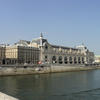Gustave Achille Guillaumet’s The Sahara is a painting depicting his adopted home.
The Sahara doesn't give a particularly cozy impression of the place, nor did Guillaumet intend to make it so. He leaves out all the prettiness of the desert and serves up a dish of desolation and death. Guillaumet knew too well of the little comfort the Sahara brought, having spent much of his time in parts of the Algerian desert. At the time, the desert was symbolic of a world outside the reach of civilization and its progress - or at least in the eyes of colonial Europeans.
Despite benefiting greatly from the French occupation of Algiers (he was once treated for malaria at a French army base there), Guillaumet hated that his adopted country was beginning to resemble Europe due to colonial influence. He wrote: “Life here no longer seems as before, held together by dreams and bringing life to the shadows.” It's ironic, because the only way these artists were able to travel so seamlessly to these regions was exactly because they were colonized by the French, and many of them took advantage of this opportunity. Taking a sojourn into the North African desert was all the rage for French artists in the late 19th century, which is why the French dominated the Orientalist movement, exoticizing the people and cultures they encountered in their depictions to the delight of their audiences back home. Unsurprisingly, The Sahara was a crowd pleaser when it was unleashed on the Salon in 1868. At the time, Oriental art won the critics’ hearts over and over again.
The best time to paint the sun, for Guillaumet, was as it rose or set. The natural landscape here is made up of two planes: the vast sky and the unending desert. All other elements, like the haunting camel skeleton and backlit silhouette of a caravan in the distance, take a back seat to the sand and sky. The painting is instead dominated by a light Guillaumet was obsessed with until his dying breath, the "golden sun." Though other works of Guillaumet's feature the flora and (live) fauna of the desert, or the people of Algeria, here he instead focuses on the solitude and the harshness of the dry terrain.
Interestingly, this is one of filmmaker Guillermo del Toro's favorite paintings in the Musee d'Orsay. In a YouTube video posted by the museum, del Toro waxes poetic about the "beautiful, symbolic serenity" of life and death in this painting, from the carcass to the caravan, and the dying (or rising) light of the sun. Ironically enough, though he works in film, what del Toro loves most about Guillaumet's work is that it achieves a balance between fantasy and reality that photography could not. Of course, if you've seen any of his films, like Pan's Labyrinth, or The Shape of Water, you will recognize his affinity for atmospheric storytelling that blends the real and the fantastic, as well as beauty and death.
















This painting seems to depict the Sahara desert almost as a villainous character. The dark, dusky colors send an ominous message that this land is unforgiving and deadly. Even the sun, whether it is rising or setting, appears to be merciless; the rising sun could represent the beginning of a day to claim more lives to the heat, and the setting sun could depict desolation as the camel remains are left pitilessly to the dark.